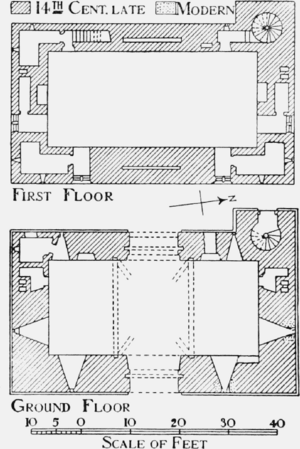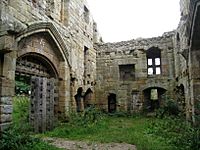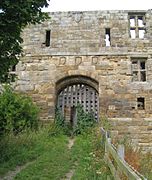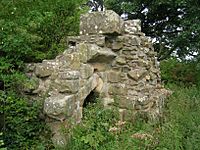Whorlton Castle facts for kids
Quick facts for kids Whorlton Castle |
|
|---|---|
| Whorlton, North Yorkshire, England | |
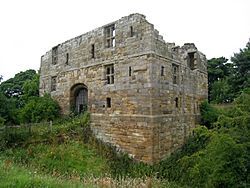
Gatehouse
|
|
| Coordinates | 54°24′55″N 1°15′36″W / 54.41528°N 1.26000°W |
| Type | Medieval castle |
| Site history | |
| Built | early 12th century |
Whorlton Castle is a ruined medieval castle. It is found near the old village of Whorlton in North Yorkshire, England. This castle was first built in the early 1100s. It started as a Norman "motte-and-bailey" castle. This means it had a raised earth mound (motte) with a wooden tower. It also had a fenced area (bailey) where people lived.
Whorlton Castle is special because it was used for a long time. It was active throughout the Middle Ages and even into more modern times. The castle was built to watch over an important road. This road was on the western edge of the North York Moors.
Even though it became a ruin by the mid-1300s, people still lived there. They stayed until at least the early 1600s. Today, not much of the main castle is left. You can still see parts of its underground rooms. The ruined shell of a 14th-century gatehouse also stands. It is not in great shape, but it is a protected building. The castle is privately owned, but you can visit it.
Contents
The Castle's Story
Whorlton Castle was built in the early 1100s. It sits on a ridge called Castle Bank. This spot was perfect for watching the road between Thirsk and Stokesley. In the 1200s, people sometimes called it Hwernelton or Potto Castle. The village of Potto is nearby.
The castle's land once belonged to Robert, Count of Mortain. He was the half-brother of William the Conqueror. Later, the de Meynell family took over. They were the ones who started building the castle.
We don't know the exact year the castle was built. At first, it was a wooden fort on a large earth mound. This mound was about 60 meters (197 feet) by 50 meters (164 feet). A dry ditch, up to 20 meters (66 feet) wide, went around the mound. Most of this ditch is still there today. The castle would have been next to a fenced area. This area included the village and the church.
The castle started to fall apart in the early 1300s. A record from 1343 said it was already a ruin. In the mid-1300s, the castle passed to John Darcy. He was a powerful lord with ties to the king. Darcy made big changes to the castle. He flattened the earth mound to build a new main tower. He also built a strong gatehouse nearby. It's not clear if there was a wall around the castle. Without one, it would have been hard to defend.
The Darcy family owned Whorlton Castle until 1418. Then, it went to Philip Darcy's daughter, Elizabeth. She was married to Sir James Strangeways. The Strangeways family kept the castle for a while. But in 1541, a family disagreement meant the castle became the king's property.
King Henry VIII later gave the castle to Matthew Stewart, 4th Earl of Lennox. His son was Henry Stuart, Lord Darnley. It's thought that Margaret Douglas, Countess of Lennox, wrote to Mary, Queen of Scots from Whorlton Castle. This was in 1561. She suggested Mary marry her son, Darnley. People used to say their marriage contract was signed here. But it was actually signed at Stirling Castle.
Later, a house was built next to the gatehouse. This was in the late 1500s or early 1600s. An old drawing from 1725 shows it was a big two-story building. No part of this house remains today. But you can still see its roofline on the gatehouse wall. By 1600, the castle was described as "old and ruinous."
In 1603, Whorlton Castle was given to Edward Bruce, 1st Lord Kinloss. His son, Thomas Bruce, 1st Earl of Elgin, became Lord Bruce of Whorlton in 1641. By the early 1800s, the castle's main tower had mostly disappeared. In 1875, much of the castle's stone was used to build the church in Swainby village.
Today, the castle is privately owned. It was bought by Osbert Peake, 1st Viscount Ingleby in the mid-1900s. It became a protected historic site in 1928. The gatehouse had some repairs in the 1960s. But it has mostly been left open to the weather.
What You Can See Today
The Gatehouse
The gatehouse from the mid-1300s is the main part of Whorlton Castle still standing. It has no roof or floors left. It is three stories high and made of sandstone. It measures about 17.68 meters (58 feet) long by 10 meters (33 feet) wide. The walls are between 6 and 8.5 meters (20 to 28 feet) tall. None of the inside walls or floors have survived.
There are two large arched entrances on each side of the gatehouse. Each entrance is about 3 meters (10 feet) wide and 3.3 meters (11 feet) high. Above the main (east) entrance, you can see three carved shields. These shields show the symbols of the Darcy, Meynell, and Gray families. They tell the story of marriages that brought the castle to the Darcys.
These entrances once had heavy wooden or metal gates called portcullises. These could be raised or lowered by winches. You can still see the grooves where the portcullises moved.
Inside, visitors would have walked through a central passage. Some parts of this passage can still be seen. On each side were large rooms. There were also smaller rooms built into the walls, likely for guards. The entire top floor would have been a great hall. You can still see parts of fireplaces on the ground and first floors.
A spiral staircase in a tower led to the upper floors. You could not get to it from the ground floor. It was accessed through a rounded doorway in the northwest wall. You can still climb the stairs to where the first floor used to be. On the outside of the gatehouse, you can see where the roof of a vanished building once joined it.
- Ruins of Whorlton Castle
Other Castle Remains
The castle's main tower, or keep, was about 22 meters (72 feet) west of the gatehouse. All that is left are parts of its vaulted cellars. The largest cellar is about 9 meters (30 feet) by 4 meters (13 feet). These cellars are thought to be from the original Norman castle. This makes them the oldest parts of the site. In the mid-1800s, a farmer reportedly used these cellars to keep pigs! Today, they are much tidier and easy to visit.
Surrounding Landscape
A large area around the castle is also part of its history. Much of this land was farmed in the Middle Ages. You can still see traces of old plowing. The area right next to the castle was designed in the late medieval period. There were ornamental gardens in two rectangular areas. Each was about 40 meters (131 feet) by 20 meters (66 feet). They were surrounded by small earth banks.
East of the gardens was a long, rectangular pond. It was 190 meters (623 feet) long and 20 meters (66 feet) wide. It was up to 3 meters (10 feet) deep. Some think it might have been a fish pond. A deer park was also created south of the castle. It is said that King Edward II once hunted there. The castle, its landscape, and the old village site are all protected as an ancient monument.
Saving Whorlton Castle
The gatehouse of Whorlton Castle is in poor condition. It is on a list of historic places at risk. The building has been damaged by people and by the weather. The castle is inside the North York Moors National Park. The park, English Heritage, and the owner are working together to save the site.
A report in 2005 looked at ways to protect the castle. One idea was to keep it as ruins but make it more secure. Another was to turn the gatehouse into a house or holiday home. A local group could also help manage the site.
Turning the gatehouse into a home was recommended. The report said that doing nothing was not a good option. This was because of ongoing damage and the high cost of future repairs. English Heritage helped pay for a study to see if this was possible. However, these plans did not work out.


